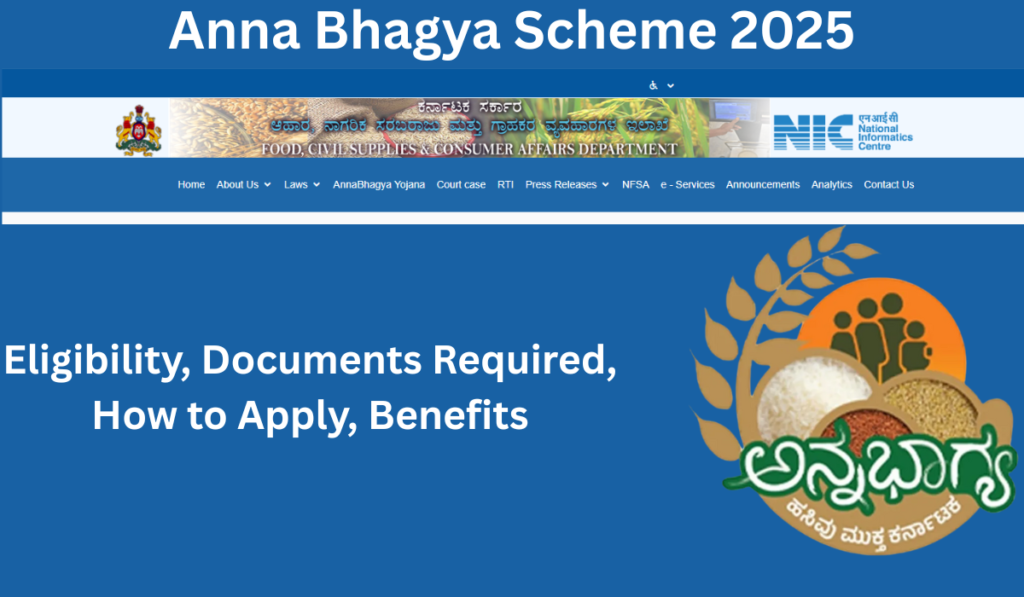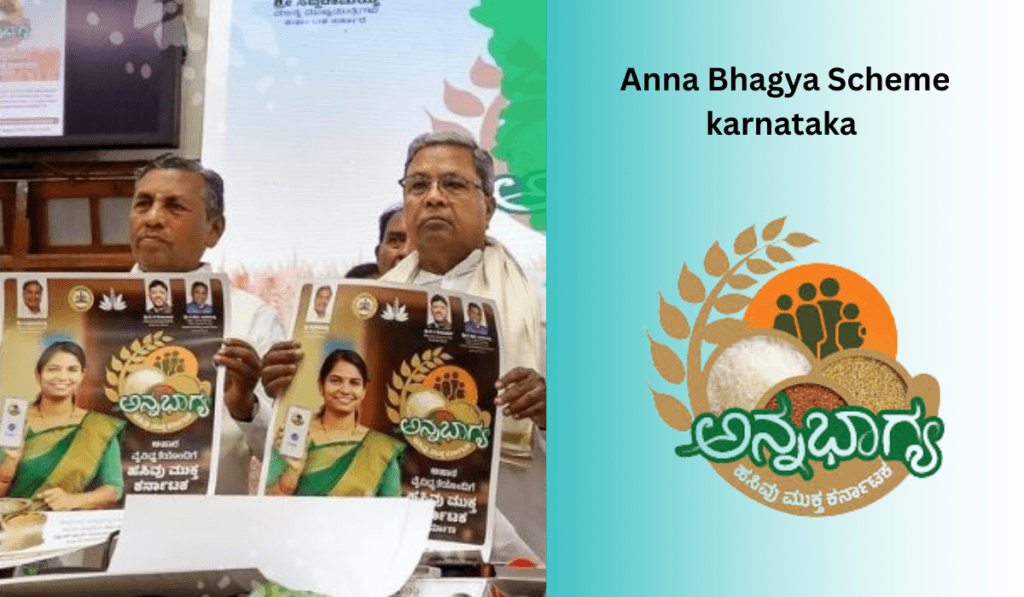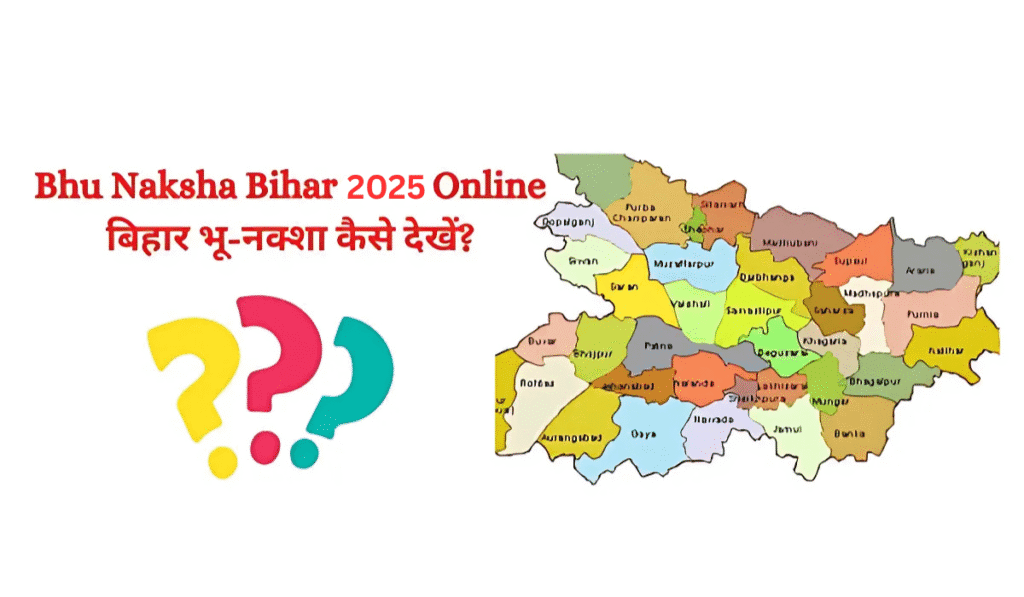
The Karnataka Government has been traditionally keen on providing food security to its people, particularly the economically weaker sections. Among its most prominent welfare programs, the Anna Bhagya Scheme stands out. The scheme was introduced in 2013 and has undergone numerous updates and refinements to serve its target group more effectively. In 2025, the government is carrying on this endeavor with added fervor, seeking to ensure that not a single citizen goes to bed on an empty stomach.
Let us get into the nitty-gritty of the Anna Bhagya Scheme 2025, discussing its goals, eligibility criteria, documents required, application process, and advantages.
What is the Anna Bhagya Scheme?
Anna Bhagya Scheme is a food subsidy scheme that offers free rice and financial assistance to Below the Poverty Line (BPL) families and Antyodaya Anna Yojana (AAY) card holders in Karnataka. The scheme is implemented by the Department of Food, Civil Supplies, and Consumer Affairs and provides nutritional security and addresses hunger by providing 10 kg of free rice per individual per month.
And if logistical or distribution problems occur, the Anna Bhagya Scheme further provides for a Direct Benefit Transfer (DBT) mechanism through which eligible households get a cash equivalent in bank accounts —of Rs 34 per kg of rice.
Key Features of Anna Bhagya Scheme 2025
- 10 kg free rice for each beneficiary each month
- Cash transfer of Rs 34 per kg in place of rice where distribution is not possible
- Specifically aimed at Karnataka’s AAY and BPL cardholders
- Smooth Direct Benefit Transfer (DBT) for monetary compensation
- Transparent and Aadhaar-linked system for improved accountability
Read More: Subhadra Yojana 2025 || Haryana Lado Laxmi Yojana
Objectives of the Anna Bhagya Scheme
- The Anna Bhagya Scheme fulfills several social welfare objectives:
- Ease Hunger: Keep no one from Karnataka hungry on account of starvation.
- Empower the Poor: Provide impoverished families with steady access to grains.
- Improve Nutrition: Improve dietary health, particularly among women, children, and the elderly.
- Decrease Poverty: By lowering household outgo on staple foods, the scheme indirectly increases disposable income.
Eligibility Criteria for Anna Bhagya Scheme 2025
To make sure that the Anna Bhagya Scheme is delivered to the most deserving, the Karnataka government has set down clear eligibility criteria. From 2025, the following categories are eligible:
1. Residency
· The applicant should be a permanent resident of Karnataka.
· Temporary residents or migrants from other states are not covered unless they possess a valid Karnataka BPL or AAY card.
2. Ration Card Type
· Should have a valid BPL (Below Poverty Line) or AAY (Antyodaya Anna Yojana) ration card from the state government.
3. Age
· Should be 18 years and above.
· All members of the household included in the ration card (all, including children) are eligible for rice entitlement.
4. Government Employment Exclusion
· Those families whose members are government servants or income tax payers are not entitled to this scheme.
5. Aadhaar Linkage
· Aadhaar should be associated with the ration card of each member of the family.
· Bank accounts too need to be Aadhaar-linked to avail DBT benefits.
Documents Required for Anna Bhagya Scheme

In addition to applying for the Anna Bhagya Scheme 2025, applicants should ensure that they have the following documents in their possession:
Ration Card (BPL or AAY) – Compulsory document for identification and eligibility.
Aadhaar Card – For all members listed on the ration card.
Proof of Residence – Karnataka domicile certificate, electricity bill, or other government proofs.
Bank Account Details – Copy of passbook or account number with Aadhaar linkage.
Mobile Number – An active mobile number to receive updates and SMS alerts.
Optional documents such as voter ID, PAN card, or caste certificate might be required in case of applying for schemes related to welfare.
Also Read: PM Matru Vandana Yojana || PM Garib Kalyan Yojana
How to Apply for Anna Bhagya Scheme 2025
In the majority of situations, families who already hold a valid BPL or AAY ration card are automatically included in the Anna Bhagya Scheme. New applicants or those who must renew their details can do the following:
Step 1: Obtain or Renew Your Ration Card
Go to the closest Food and Civil Supplies Department office or apply online through the Ahara Karnataka Portal (ahara.kar.nic.in).
Complete the forms and submit the documents.
Make sure the Aadhaar numbers of all the family members are properly linked to the ration card.
Step 2: Link Aadhaar and Bank Account
Go to your bank and get your account Aadhaar-seeded.
This is imperative in order to get DBT transfers, in the event of not distributing rice.
Step 3: Biometric Authentication
After enrollment, go to your local Public Distribution System (PDS) or fair price shop.
Show your ration card and get biometrically verified through Aadhaar.
Step 4: Avail Monthly Benefits
After successful verification, receive the 10 kg rice per family member as allotted.
In case of unavailability of rice due to supply constraints, the monetary value will be credited directly to your bank account.
How to Check DBT Payment Status
Beneficiaries who are paid in cash in place of rice can monitor their payment status through the following steps:
Go to the Anna Bhagya DBT Status Page
Click on “e-Services” → “e-Status” → “DBT Status”
Enter:
District
Ration card number
Month and year
Captcha code
Click “Go” to get DBT transaction history and payment status.
Benefits of the Anna Bhagya Scheme
The Anna Bhagya Scheme offers various benefits in addition to the distribution of food grain:
1. Nutritional Security
When the rice is available easily, this ensures that the families will get their daily caloric needs; this leads to better health outcomes, particularly among children and the elderly.
2. Economic Relief
With the distribution of free rice or cash equivalent to rice, families save good amount on monthly expenditure on food.
3. Empowerment of Women
As most of the ration cards are on the names of women, the Anna Bhagya Scheme augment their importance in domestic well-being.
4. Transparent Delivery
The scheme decreases pilferage and gives benefits to only the deserving with Aadhaar-based biometric verification and DBT.
5. Support During Crises
During natural catastrophes, inflationary crises, or disruption in supply, DBT supports families not going hungry.
See More: PM Kisan Samman Nidhi Yojana || Mahtari Vandana Yojana
Challenges and Improvements
Although the Anna Bhagya Scheme has been overall successful, there are some continuing issues:
Distribution Gaps: Sometimes ration shops experience delays or shortages in the supply of rice.
Aadhaar Seeding Mistakes: Mistakes in Aadhaar linkage may deny benefits to families.
Digital Divide: For monitoring the DBT status, not all beneficiaries have easy access to digital services.
For overcoming these challenges, the government of Karnataka is constantly enhancing the Ahara portal, the last-mile delivery mechanisms, and conduct public sensitization programs to make people aware of linking Aadhaar and renewing documents.
Contact Details for Help and Queries
If you are facing any issue related to the Anna Bhagya Scheme, you can reach out to the following:
Toll-Free Help lines:
· 1967 or 1800-425-9339
Email:
· foodcom-ka@nic.in
Website:
· http://ahara.kar.nic.in
Conclusion
Anna Bhagya Scheme 2025 is a crucial welfare scheme; it reflects the commitment of the Karnataka state towards food security as well as social justice.
It has strong design, smooth DBT mechanism, and clear delivery, thus the program not only fights hunger but also raises the bottom-line poor families by providing them with dignity and assistance.
As Karnataka advances further in public welfare innovation, the Anna Bhagya Scheme remains a beacon of hope, guaranteeing that all citizens — irrespective of income level — enjoy their basic right to food.


